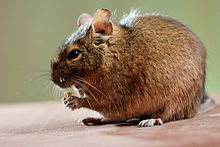| Octodontids Temporal range:
| |
|---|---|

| |
| Common degu, Octodon degus | |
| Scientific classification | |
| Domain: | Eukaryota |
| Kingdom: | Animalia |
| Phylum: | Chordata |
| Class: | Mammalia |
| Order: | Rodentia |
| Suborder: | Hystricomorpha |
| Infraorder: | Hystricognathi |
| Parvorder: | Caviomorpha |
| Superfamily: | Octodontoidea |
| Family: | Octodontidae Waterhouse, 1839 |
| Type genus | |
| Octodon Bennett, 1823
| |
| Genera | |
|
Aconaemys | |
Octodontidae is a family of rodents, restricted to southwestern South America. Fourteen species of octodontid are recognised, arranged in seven genera. The best known species is the common degu, Octodon degus.
Octodontids are medium-sized rodents, ranging from 12 to 20 centimetres (4.7 to 7.9 inches) in body length. They have long, silky fur, which is typically brownish in color and often paler on the underside. The name 'octodont' derives from the wear pattern of their teeth, which resembles a figure 8. Most are nocturnal, social, burrowing animals, though the degu is largely diurnal. They are herbivorous, eating tubers, bulbs, and cactuses.[1]
Some authors have suggested that the octodontids should be reclassified in the order Lagomorpha, but this has not been supported by further analyses.[2] Older literature includes the tuco-tucos in the family, as the subfamily Ctenomyinae, but these animals are normally now treated as a separate family, Ctenomyidae. There is some evidence that evolution within the family may have resulted from polyploidy. The red viscacha rat, Tympanoctomys barrerae, has been proposed to be a tetraploid, with 102 chromosomes.[3][4] However, subsequent studies have shown that the increased genome size is due to expansions of repetitive DNA elements.[5][6]
Members of the genus Aconaemys are referred to as rock rats, and members of genera Octodon and Octodontomys are called degus, though the name degu on its own historically implied Octodon degu. The single member of Spalacopus, S. cyanus, is called the coruro. Members of the other genera are called 'viscacha rats'.
- ^ Bishop, Ian (1984). Macdonald, D. (ed.). The Encyclopedia of Mammals. New York: Facts on File. pp. 702. ISBN 0-87196-871-1.
- ^ Opazo, J.C. (August 2005). "A molecular timescale for caviomorph rodents (Mammalia, Hystricognathi)". Molecular Phylogenetics and Evolution. 37 (3): 932–937. doi:10.1016/j.ympev.2005.05.002. PMID 16085429.
- ^ Gallardo, Milton H.; Bickham, J. W.; Honeycutt, R. L.; Ojeda, R. A.; Köhler, N. (September 1999). "Discovery of tetraploidy in a mammal". Nature. 401 (6751): 341–341. doi:10.1038/43815.
- ^ Gallardo, M.H.; González, C.A.; Cebrián, I. (August 2006). "Molecular cytogenetics and allotetraploidy in the red vizcacha rat, Tympanoctomys barrerae (Rodentia, Octodontidae)". Genomics. 88 (2): 214–221. doi:10.1016/j.ygeno.2006.02.010.
- ^ Svartman, Marta; Stone, Gary; Stanyon, Roscoe (2005). "Molecular cytogenetics discards polyploidy in mammals". Genomics. 85 (4): 425–30. doi:10.1016/j.ygeno.2004.12.004. PMID 15780745.
- ^ Graphodatsky, Alexander S.; Trifonov, Vladimir A.; Stanyon, Roscoe (12 October 2011). "The genome diversity and karyotype evolution of mammals". Molecular Cytogenetics. 4 (1): 22. doi:10.1186/1755-8166-4-22. PMC 3204295.